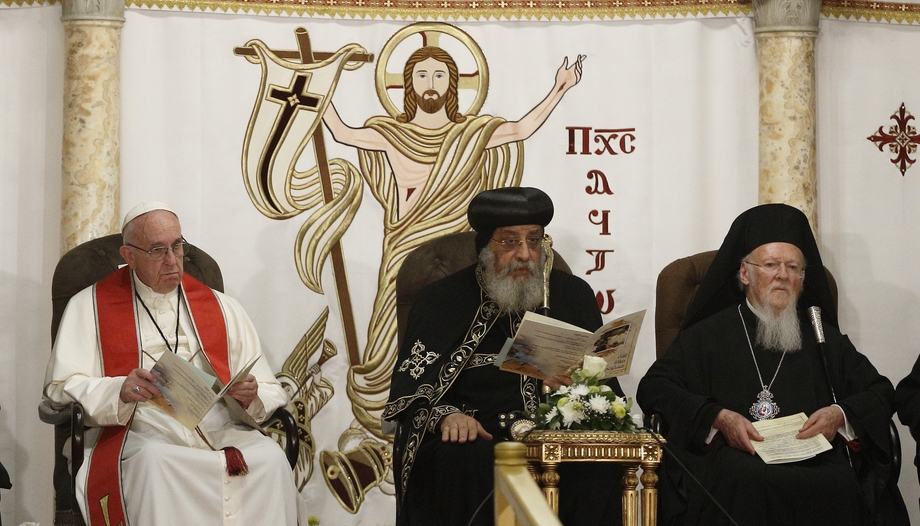On the occasion of the 50th anniversary of the meeting between St. Paul VI and Shenouda III, Patriarch Tawadros will attend the General Audience on Wednesday, May 10. On Thursday, May 11, he will hold a private meeting with Pope Francis, with whom he will have a moment of prayer, and then visit the Dicastery for Promoting Christian Unity.
The Patriarch will also meet with the faithful of the Coptic community residing in Rome, for whom he will celebrate a Eucharistic liturgy in the papal basilica of St. John Lateran on Sunday, May 14.
The Coptic Church
The Coptic Church is the main Christian church in the country. EgyptThe theologically characterized by the Monophysite confession, which distinguishes it from Catholicism and the so-called Orthodox confession, but unites it with the Syro-Jacobite Church.
It has its origin in the schism of the Monophysites after the Council of Chalcedon (451) and from it derived the Coptic Church of Nubia, now disappeared, and the Coptic Church of Ethiopia, which continued to depend hierarchically on it until 1959.
It has about 10 million faithful who reside mainly in Upper Egypt, but also in Sudan, Palestine, Jerusalem and other countries of the Middle East. The ecclesiastical hierarchy is formed by the Patriarch (whose official title is "Pope of Alexandria and Patriarch of the See of St. Mark"), resident in Cairo, about sixty metropolitans and bishops members of the Holy Synod and other bishops with special assignments or residing outside Egypt.
It also includes some 1,500 married priests and hundreds of monks. It is a member of the Ecumenical Council of Churches and other ecumenical organizations, has sent observers to the Second Vatican Council and initiated a doctrinal dialogue with the Catholic Church (in 1973 its Patriarch Shenouda III paid an official visit to Paul VI).
There is also a Coptic Catholic Church, the Catholic Patriarchate of Alexandria, erected in 1824, reestablished in 1895 and governed by a patriarch. It comprises 6 dioceses with about 200,000 faithful.
The Pope and Tawadros II: An Ecumenical Journey
"The Coptic Orthodox Church in Egypt," reports a tweet from the Secretariat of State, "is one of the most important realities in the ecclesial panorama of the Middle East, where, in recent times, Christian communities are facing situations of great difficulty."
In an interview granted to the Vatican media last April, Father Hyacinthe Destivelle, head of the Dicastery for Unity, had described this important visit as a "milestone" in the ecumenical journey.
The Joint Declaration signed by Pope Montini and Patriarch Shenouda on May 10, 1973 served "as a model for similar agreements with the other Eastern Orthodox Churches, which recognize the first three Councils".
Prayer meeting with the Pope
At the heart of the May 11 prayer meeting is the theme of the ecumenism of blood, in memory of the many martyrs of the different Christian confessions.
There have already been important steps in the past, such as the sending of observers to the Second Vatican Council by Patriarch Cyril, the return of the relics of St. Mark in 1968, the aforementioned visit in '73 and the initiation of a bilateral Joint Commission between the Coptic and Catholic Churches.
Theological relations now take place within the framework of a Joint Commission between the Catholic Church and all the Eastern Orthodox Churches in which the Coptic Church plays a special role, because the co-chairman is from the beginning a Coptic bishop.
Liturgical celebration
On May 14, the Patriarch will celebrate with his faithful, who number around 100,000 in Italy, in the Basilica of St. John Lateran. In this case, the use of the Cathedral of the Bishop of Rome has been granted taking into account the historical character of the visit and the number of faithful, who will surely be thousands.
The Patriarch will not celebrate at the altar of the Pope, he will have his own altar where he will officiate the liturgy in the Coptic rite. It should be noted in this regard that the Ecumenical Directory states in point 137 that "if priests, ministers or communities who are not in full communion with the Catholic Church do not have a place or the liturgical objects necessary to celebrate their religious ceremonies worthily, the diocesan bishop may allow them to use a Catholic church or building and also lend them the objects necessary for their worship".
This is also explained in point 33 of the Ecumenical Vademecum. Moreover, the Coptic Orthodox Church is an apostolic Church whose sacraments are recognized by the Catholic Church and which shares the same conception of the Eucharist and the priesthood. Given the special character of the visit, this authorization was also intended to be a fraternal gesture addressed to the Coptic Church.
The martyrs: a bridge of union
We all have in mind the martyrdom of the 21 Copts in Libya, killed on February 15, 2015, of whom Pope Francis has always said, "They are also our martyrs."
The common prayer will take place in the chapel Redemptoris Mater of the Apostolic Palace on the theme of the "ecumenism of blood". "For Pope Francis - said Father Destivelle - the blood of the martyrs is the seed of unity. The martyrs are already gathered in heaven, the Pope always says, they are not killed because they are Catholics, Orthodox or Protestants, but because they are Christians. So they are already gathered in the glory of God because they suffered for the name of Christ. The blood of the martyrs cries out louder than our divisions".








